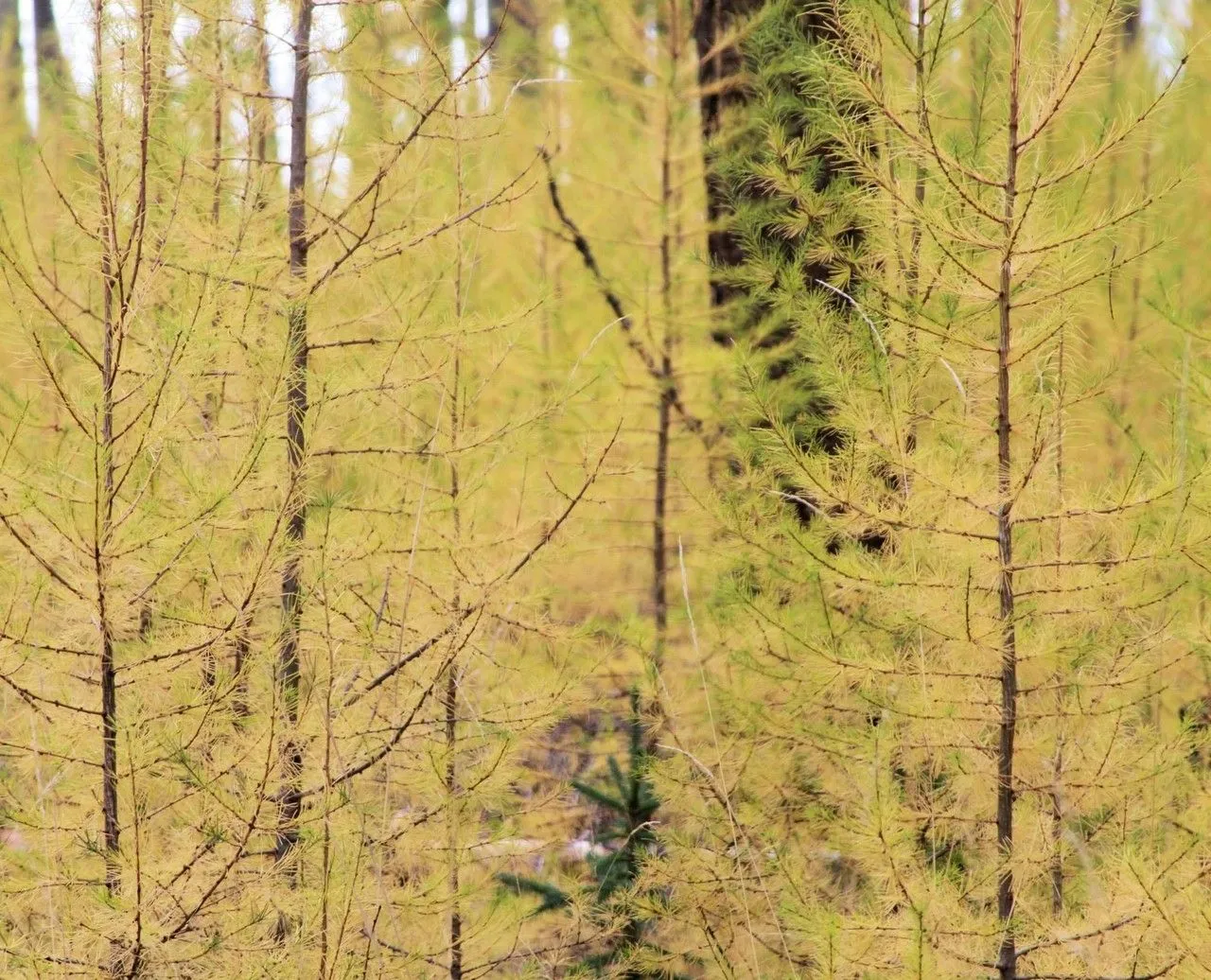
Author: Nutt.
Bibliography: N. Amer. Sylv. 2: 199 (1846)
Year: 1846
Status: accepted
Rank: species
Genus: Larix
Vegetable: False
Observations: W. Canada to NW. U.S.A.
Western larch, scientifically known as Larix occidentalis, is a captivating tree species that hails from the Pinaceae family. First documented in N. Amer. Sylv. 2: 199 (1846) by the esteemed botanist Nutt., this tree has secured its place within the diverse flora of North America.
This deciduous conifer, unlike many of its evergreen relatives, sheds its needles in the autumn, revealing a splendid seasonal transformation. In the spring and summer, the needles of the Western larch are a vibrant green, gracing the landscape with their lush, feather-like appearance. As the months transition to autumn, these needles turn a radiant golden-yellow before they fall to the ground, creating a striking contrast against the evergreen surroundings.
The Western larch is predominantly native to regions of Western Canada and Northwestern United States, thriving in climates that provide sharp seasonal distinctions. It is a highly adaptable species, commonly found in mountainous terrains where it can take advantage of well-drained soils and ample sunlight. Its resilience and adaptability to cold conditions make it a prominent feature in the subalpine and montane zones where it coexists with other coniferous species.
A mature Western larch stands tall and dignified, capable of reaching impressive heights typically between 30 to 60 meters (98 to 197 feet), with a trunk diameter that often expands up to 1 meter (3.3 feet). The tree’s bark is rough and flaky, offering a sturdy base to its towering stature. The branches extend horizontally and are characteristically covered with slender, needle-like leaves during the growing season.
The cones of the Western larch are another distinctive feature of this majestic tree. They are small, ranging from 2 to 5 centimeters in length, with an ovate to oblong shape. Mature cones are red-brown to purplish and help in the regeneration of new saplings by dispersing seeds across the forest floor. Each seed is equipped with a small wing, allowing it to travel with the wind to find a suitable spot for germination.
Ecologically, Larix occidentalis plays a vital role in its habitat. It provides shelter and food for various wildlife species, including birds and small mammals, which rely on its seeds as a food source. Additionally, the Western larch contributes to soil stabilization and nutrient cycling within forest ecosystems.
Historically, indigenous peoples and early settlers utilized the Western larch for its robust wood, which is highly valued for its durability and strength. It is still used today in construction, particularly in making railroad ties, telephone poles, and other structures requiring sturdy, long-lasting timber.
In summary, the Western larch is a remarkable and resilient conifer that stands as a testament to nature’s beauty and diversity. Its striking seasonal changes, ecological significance, and utilitarian value make it an essential component of the forests in Western Canada and the Northwestern United States.
Ita: larice occidentale
Eng: montana larch, western larch, hackmatack, mountain larch, western tamarack
Hun: nyugat-amerikai vörösfenyo
Deu: westamerikanische lärche
Nld: westerse lork
Swe: kaskadlärk
Fra: mélèze de l’ouest, mélèze occidental
Rus: лиственница западная (listvennica zapadnaya)
Zho: 美国西部落叶松 (mei guo xi bu luo ye song)
En: Western larch, Montana larch, Hackmatack, Mountain larch, Western tamarack
Ar: أرزية غربية
Az: Qərb qara şamı
Bg: Западна лиственица
Zh: 西部落葉松, 美国西部落叶松 (mei guo xi bu luo ye song)
Nl: Westerse lork
Eo: Okcidenta lariko
Fi: Lännenlehtikuusi
Fr: Mélèze de l’Ouest, Mélèze occidental
De: Westamerikanische Lärche
He: ארזית מערבית
Hu: Nyugati vörösfenyő, Nyugat-amerikai vörösfenyo
Is: Risalerki
It: Larice occidentale
Lt: Vakarinis maumedis
No: Kjempelerk
Fa: سیاهکاج غربی
Pl: Modrzew zachodni
Ru: Лиственница западная, Лиственница западная (listvennica zapadnaya)
Sv: Kaskadlärk
Zh-hant: 西部落葉鬆
Uk: Модрина західна
© copyright of the Board of Trustees of the Royal Botanic Gardens, Kew.
© copyright of the Board of Trustees of the Royal Botanic Gardens, Kew.
© copyright of the Board of Trustees of the Royal Botanic Gardens, Kew.
Taken May 8, 2020 by Лейсан (cc-by-sa)
Taken Oct 4, 2020 by Horatiu Bodea (cc-by-sa)
Taken Aug 10, 2020 by patrib (cc-by-sa)
Taken Oct 22, 2020 by Marie-Christine Rothier (cc-by-sa)
Taken Nov 19, 2017 by Gym Skuteč (cc-by-sa)
Taken Jan 1, 1900 by EOL − Walter Siegmund (cc-by)
Taken Apr 26, 2015 by EOL − Jon David Nelson (cc-by-nc)
Taken Jan 1, 1900 by EOL − Niehaus, T.F. (cc-by-nc-sa)
Taken Oct 24, 2021 by Manuëlle (cc-by-sa)
Taken Jan 1, 1900 by EOL − Walter Siegmund (cc-by)
Taken Oct 4, 2022 by Sara Tischer (cc-by-sa)
Taken Jan 1, 1900 by EOL − Niehaus, T.F. (cc-by-nc-sa)
Taken Oct 24, 2021 by Manuëlle (cc-by-sa)
Taken Jun 15, 2019 by Thierry Salem (cc-by-sa)
Taken Oct 19, 2014 by EOL − Zoya Akulova (cc-by-nc)
Taken Sep 10, 2020 by Cristian (cc-by-sa)
Taken Jan 1, 1900 by EOL − Encyclopedia of Life (public)
Taken Oct 12, 2022 by Phil Ironside (cc-by-sa)
Taken Oct 19, 2014 by EOL − Zoya Akulova (cc-by-nc)
Taken Sep 27, 2020 by Michael Schmitz (cc-by-sa)
Taken Jun 2, 2020 by Basova Diana (cc-by-sa)
Taken Jun 1, 2020 by Paolo Giacomino (cc-by-sa)
Taken Oct 19, 2014 by EOL − Zoya Akulova (cc-by-nc)
Taken Jul 10, 2019 by Leitia D’Aguiar (cc-by-sa)
Taken May 26, 2022 by julia ban (cc-by-sa)
Growth form>: Single Stem
Growth habit>: Tree
Growth rate>: Rapid
Ph maximum: 7.0
Ph minimum: 6.0
Family: Myrtaceae Author: (F.Muell.) K.D.Hill & L.A.S.Johnson Bibliography: Telopea 6: 402 (1995) Year: 1995 Status:…
Family: Rubiaceae Author: Pierre ex A.Froehner Bibliography: Notizbl. Bot. Gart. Berlin-Dahlem 1: 237 (1897) Year:…
Family: Sapindaceae Author: Koidz. Bibliography: J. Coll. Sci. Imp. Univ. Tokyo 32(1): 38 (1911) Year:…
Family: Asteraceae Author: A.Gray Bibliography: Pacif. Railr. Rep.: 107 (1857) Year: 1857 Status: accepted Rank:…
Family: Fabaceae Author: Medik. Bibliography: Vorles. Churpfälz. Phys.-Ökon. Ges. 2: 398 (1787) Year: 1787 Status:…
Family: Aspleniaceae Author: (Cav.) Alston Bibliography: Bull. Misc. Inform. Kew 1932: 309 (1932) Year: 1932…